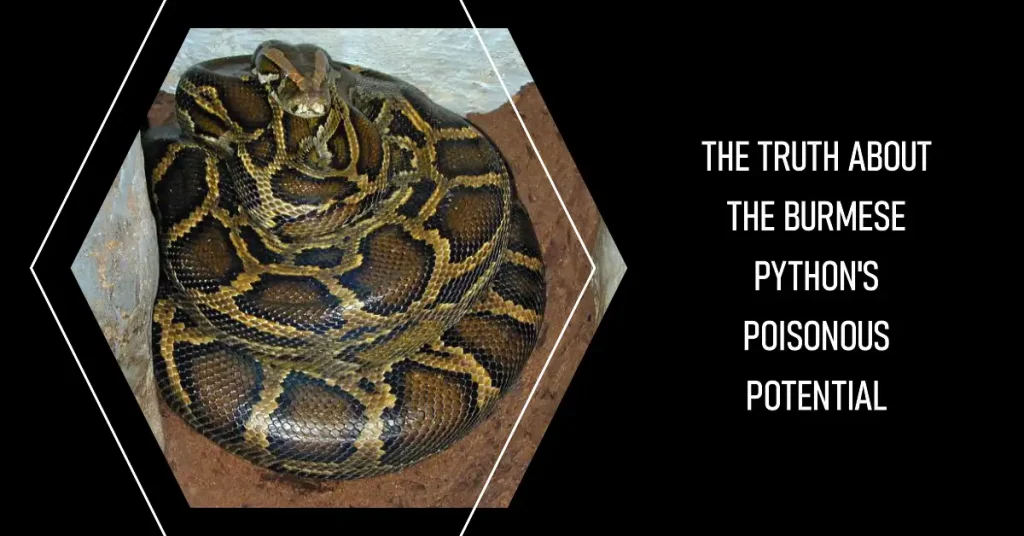Burmese pythons are not poisonous. They are constrictors, meaning they subdue their prey through constriction, which involves wrapping their bodies around the prey and tightening their coils to induce suffocation. Unlike venomous snakes that inject toxins into their prey, constrictors rely on physical strength to capture and kill.
In the following paragraphs, we will discuss this topic in more detail…
Today, I want to address a common question that many people have about Burmese pythons: are they poisonous?
First, let’s clarify the terminology. “Poisonous” refers to an animal that is harmful when ingested or touched, while “venomous” means an animal that injects venom through a bite or sting.
So, are Burmese pythons venomous or poisonous? The answer is straightforward: Burmese pythons are not venomous, nor are they poisonous.
My aim is to provide accurate information and dispel any misconceptions about Burmese pythons. In this article, I will explore the characteristics of Burmese pythons and their potential danger to humans. Additionally, I will provide safety precautions and guidance on how to handle snake encounters.
Key Takeaways:
- Contrary to popular belief, Burmese pythons are not poisonous or venomous.
- It is important to understand the distinction between poisonous and venomous before delving into the specifics of Burmese pythons.
- By understanding the behavior of Burmese pythons, individuals can reduce the risk of harm when encountering them.
- Precautions should be taken when encountering any snake species, regardless of their level of toxicity.
Understanding the Difference Between Poisonous and Venomous
Before we explore whether Burmese pythons are poisonous or venomous, it’s important to understand the difference between these two terms. While they may seem interchangeable, they actually refer to two different ways that organisms can cause harm.
A poisonous animal carries toxins that it can passively transmit to another organism. Poisoning typically occurs when someone ingests or comes into contact with the animal’s skin or glands. In contrast, a venomous animal actively delivers venom through a bite or sting. Venom usually causes harm by destroying tissue or interfering with the nervous system.
When it comes to snakes, most species are venomous rather than poisonous. This is because snakes use venom to kill or immobilize their prey. While some snakes also have skin secretions that are toxic to humans, these toxins are not typically considered “poisonous.”
It’s important to note that venomous snakebites can be life-threatening and require prompt medical attention. In the following sections, we’ll provide information on how to recognize venomous snakes and what to do in the event of a snakebite.
The Behavior of Burmese Pythons
As one of the largest snake species in the world, Burmese pythons are known for their impressive size and strength. While they are not venomous, their behavior can still pose a potential danger to humans. Comprehending their behavior is crucial for minimizing any risks when encountering them.
Burmese pythons are typically found in tropical and subtropical regions, including Southeast Asia and certain areas of Florida in the United States. They prefer habitats with plenty of vegetation and water sources, and can often be found in swamps, marshes, and other wetlands.
When it comes to feeding habits, Burmese pythons are known to consume a variety of prey, including small mammals, birds, and even other reptiles. They are opportunistic feeders and can wait for extended periods to ambush their prey.
While not inherently aggressive toward humans, Burmese pythons may become defensive if they feel threatened or cornered. They may hiss, bite, or strike out if they perceive a threat. It is important to always approach them with caution and give them plenty of space to avoid any aggressive behavior.
Potential Risks of Burmese Pythons
While Burmese pythons are not venomous, there are certain behaviors or situations that could pose a threat to humans. It’s important to take necessary precautions to minimize any potential risks when encountering these snakes.
One potential risk is aggression towards humans. Burmese pythons are large, powerful snakes that may feel threatened by human presence. If a snake feels cornered or provoked, it may lash out and bite in self-defense. While not venomous, a Burmese python bite can still be painful and may cause infection if not treated promptly.
Another risk is accidental injury caused by handling or attempting to catch a Burmese python. Inexperienced handlers may not be prepared for the snake’s size and strength, leading to accidents that could result in serious injury.
To minimize any potential risks when encountering Burmese pythons, it is important to follow these safety precautions:
- Do not approach or attempt to catch a wild Burmese python.
- If you encounter a Burmese python, keep a safe distance and allow it to move away on its own.
- If you must handle a Burmese python, do so with caution and only if you are trained and experienced in snake handling.
- Wear protective gear, such as gloves and boots, to reduce the risk of bites and injury.
- If you are bitten by a Burmese python, seek medical attention immediately to prevent infection and receive appropriate treatment.
By taking these precautions and respecting the behavior and potential danger of Burmese pythons, individuals can minimize any potential risks and protect themselves when encountering these snakes.
Identifying Venomous Snakes and Toxic Snake Species
Knowing how to identify venomous snakes and toxic species is crucial for understanding the potential dangers of encountering these creatures. Here are some tips to help you discern between venomous and non-venomous snakes:
- Head shape: Venomous snakes typically have triangular heads, while non-venomous ones have more rounded heads.
- Pupil shape: Venomous snakes usually have vertical or slit-shaped pupils, while non-venomous ones have round pupils.
- Coloration: This can vary widely among species, but some venomous snakes have distinctive coloration patterns such as red, yellow, and black bands.
It is important to keep in mind that not all venomous snakes are deadly, and not all non-venomous snakes are harmless. Some non-venomous species can still deliver painful bites or cause allergic reactions. It is always best to err on the side of caution and avoid handling snakes whenever possible.
“Remember, the best way to avoid a snakebite is to give snakes plenty of space and respect their territory.”
If you do encounter a venomous snake, it is crucial to seek medical attention immediately if bitten. Delaying treatment can result in serious complications, including tissue damage and even death. Knowing some basic first aid measures can also help in the interim:
- Stay calm: Panicking can increase heart rate and spread the venom more quickly through the body.
- Remove jewelry: Swelling can occur rapidly, making it difficult to remove rings or bracelets later.
- Keep the affected limb immobilized: Try to keep the bite below heart level and avoid moving it excessively.
- Seek medical attention: Call 911 or your local emergency services as soon as possible. Do not attempt to drive yourself to the hospital.
By being aware of the characteristics of venomous snakes and knowing how to respond in the event of a snakebite, you can minimize any potential risks and stay safe when exploring nature.
Symptoms of Snakebite and Snakebite Treatment
If you are bitten by a snake, it is crucial to be aware of the symptoms and take prompt action. The severity of a snakebite can vary depending on the type of snake and the amount of venom injected, so it is essential to stay calm and seek medical attention immediately.
The symptoms of a snakebite can include:
- Puncture wounds or two small puncture marks on the skin
- Swelling and redness around the bite area
- Pain or burning sensation around the bite area
- Nausea and vomiting
- Sweating and fever
- Difficulty breathing or shortness of breath
- Changes in heart rate and blood pressure
If you experience any of these symptoms after being bitten by a snake, it is important to seek medical attention as soon as possible.
While waiting for medical help, there are a few things you can do to manage the symptoms:
- Stay calm and still to slow the spread of venom in your body.
- Remove any tight clothing or jewelry that may constrict blood flow in case of swelling and spreading of venom.
- Keep the affected limb immobilized and at or below heart level to reduce blood flow rate.
- Avoid using ice, cold compresses or tourniquets, as these can worsen the symptoms.
- Drink plenty of water to stay hydrated and help flush the venom out of your system.
When you arrive at a medical facility, a healthcare professional will assess your symptoms and give you appropriate treatment. Treatment for a snakebite may include:
- Antivenom, which is a type of medication that can neutralize the venom in your body
- Pain relief medication, such as analgesics
- Antibiotics, if there is a risk of infection
- Tetanus shot, if you haven’t had one in the past five years
Remember:
If you are bitten by a snake, seek medical attention immediately. Do not wait to see if symptoms develop, as this can lead to serious complications.
Are Burmese Pythons Harmful to Humans?
After exploring the characteristics and behavior of Burmese pythons, it’s clear that they are not venomous or poisonous to humans. However, this does not mean that they are entirely harmless.
Like any wild animal, Burmese pythons can exhibit unpredictable behavior if they feel threatened or cornered. While they are unlikely to attack humans, they may become defensive if they perceive danger. In rare cases, this could result in a bite or constriction, which in itself can be dangerous.
It’s important to remember that Burmese pythons are still large and powerful animals that should be treated with respect and caution. If you do encounter a Burmese python, keep a safe distance and do not attempt to approach or handle it.
It’s also important to note that the risk of encountering Burmese pythons in the wild is relatively low. This is because they are not native to most parts of the world and are typically found in specific regions, such as Southeast Asia and parts of Florida.
Precautions When Encountering Burmese Pythons
While Burmese pythons are not venomous or poisonous, encountering them in the wild can still be risky. Here are some precautions to take:
- Stay at a safe distance: If you see a Burmese python in the wild, keep a safe distance from it. Do not approach it or try to touch it.
- Be aware of their habitat: Burmese pythons are often found near water sources and in areas with dense vegetation. Be cautious when in these environments, and keep an eye out for any snakes in the area.
- Be cautious during breeding season: Burmese pythons can be more aggressive during certain times of the year, such as breeding season. If you encounter a python during this time, exercise extra caution.
- Wear protective clothing: If you’re going to be in an area known to have Burmese pythons, consider wearing boots and long pants to protect your legs from potential bites.
- Don’t handle them: Even though Burmese pythons are not venomous or poisonous, they can still bite and cause injury. Do not handle them unless you are a trained professional.
By taking these precautions, you can minimize any potential risks associated with encountering Burmese pythons. Remember to always exercise caution and respect for these animals when in their territory.
Are Burmese Pythons Venomous – Conclusion
After exploring the characteristics and behavior of Burmese pythons, we can conclude that they are not poisonous or venomous snakes. While they may pose a threat to humans in certain situations, it is important to understand that their danger lies in their strength and size rather than the toxicity of their venom.
It is crucial to exercise caution when encountering Burmese pythons and follow safety precautions. Always maintain a safe distance and avoid provoking or approaching them. If an encounter occurs, remember to remain calm and seek help if necessary.
By understanding the difference between poisonous and venomous and recognizing the symptoms of snakebite, individuals can take appropriate measures to ensure their safety. While Burmese pythons are not inherently harmful to humans, it is important to approach all snakes with respect and caution.



